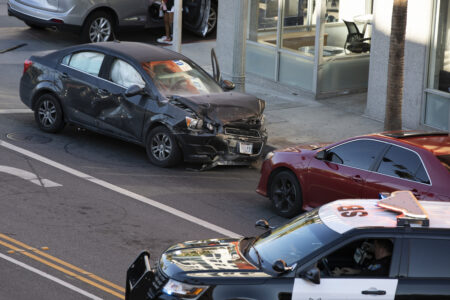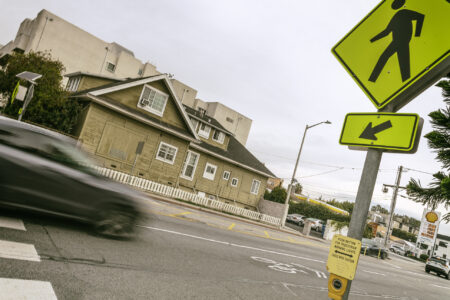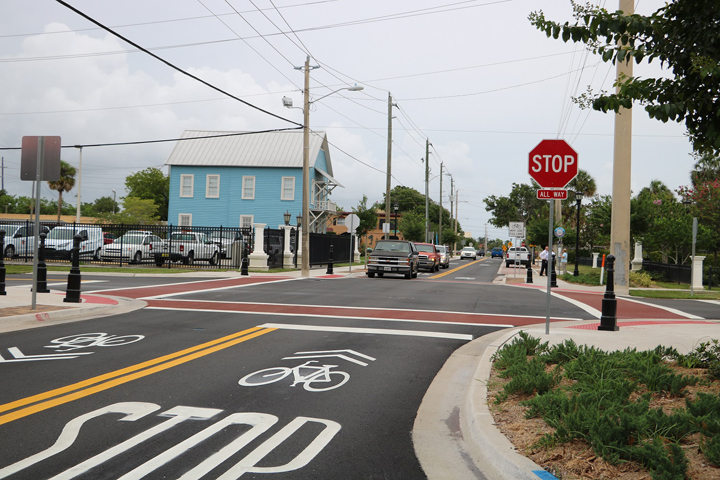
Share On Social!
In 1984, Florida transportation leaders crafted the state’s first policy for Complete Streets, which aim for safe access for all users, including pedestrians, bicyclists, motorists and transit riders.
The policy worked.
It saved 3,500 lives in 30 years, according to a study.
But, even with a three-decade decline in pedestrian deaths, Florida remains car-dependent and repeatedly ranks among the most dangerous states for pedestrians and bicyclists.
What could transportation leaders do now?
Their answer: Reinvent how they implement Complete Streets.
Read more below in Part 1 of Salud America!’s three-part series on transportation changes in Florida. Part 2 will examine the potential for transit integration. Part 3 will cover pedestrian death reduction.
Why Didn’t the 1984 Complete Streets Policy Solve the Problem?
Complete Streets have many benefits: saving lives, reducing car dependence and greenhouse gas emissions, promoting economic development, and improving people’s physical and mental health.
The Florida Department of Transportation’s (FDOT) 1984 Complete Streets policy did save lives.
Complementary state transportation policies, like the Transportation Design for Livable Communities policy adopted in 1998, allowed planners and engineers to create safety features (e.g., speed limits, sidewalks, crosswalks) for pedestrians, bicyclists, motorists and public transit users.
Additionally, trained state and local transportation leaders at district, county and city levels advanced pedestrian safety efforts aligned with the Complete Streets policies and helped educate their colleagues.
But why do thousands of deaths still occur on Florida streets every year? Why do many still cite Florida as an unsafe place for people who walk and bike?
Because of barriers to implementation of the 1984 policy, researchers say.
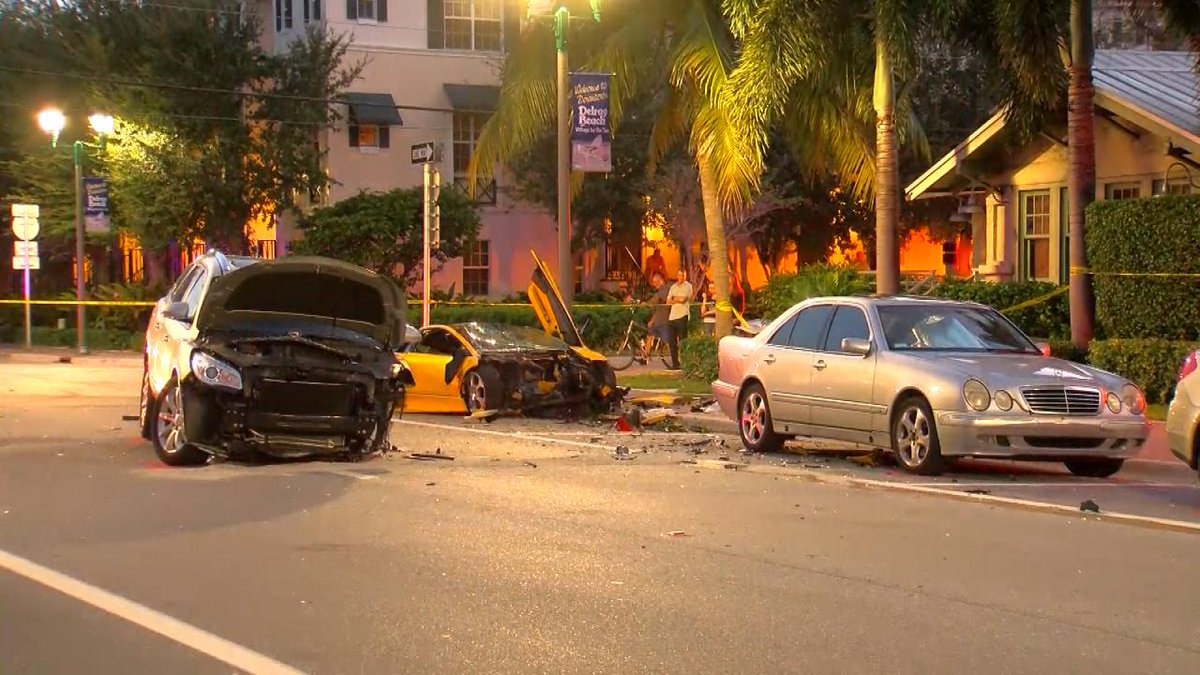
Researchers found lack of state oversight and local accountability; inflexible land use and zoning policies; uninformed decision-making by transportation agency staff and elected officials; and performance metrics that prioritize motor vehicles.
“Several interviewees noted that some transportation staff and local elected officials have been too eager to reap the financial benefits of proposed residential and retail developments without considering the consequences of these land use decisions,” researchers state.
The state continued to use performance metrics that prioritize motor vehicles, like vehicular Level of Service (LOS)─which evaluates how many vehicles and how fast vehicles can travel on a roadway.
Using the LOS tends to expand roadways and increase vehicular speeds to benefit automobiles only.
So, for years, without accountability and multimodal performance measures, Florida’s districts, counties, and cities continued to design wide-open thoroughfares through suburban and urban areas without accommodating pedestrians, bicyclists and transit users.
Florida continued to plan road projects without multi-modal methods in mind and continued to design streets for higher speeds than the speed limit.
“While infrastructure for walking and biking was tacked on to projects, the state still focused on moving motor vehicles, not creating safe bike and pedestrian networks,” wrote Angie Schmitt in Streetsblog USA.
Successful Complete Streets performance measures need to evaluate more than capacity and speed for vehicles; they need to evaluate access, safety and health for all ages, abilities, and modes of travel, like Multimodal Levels of Service (MMLOS).
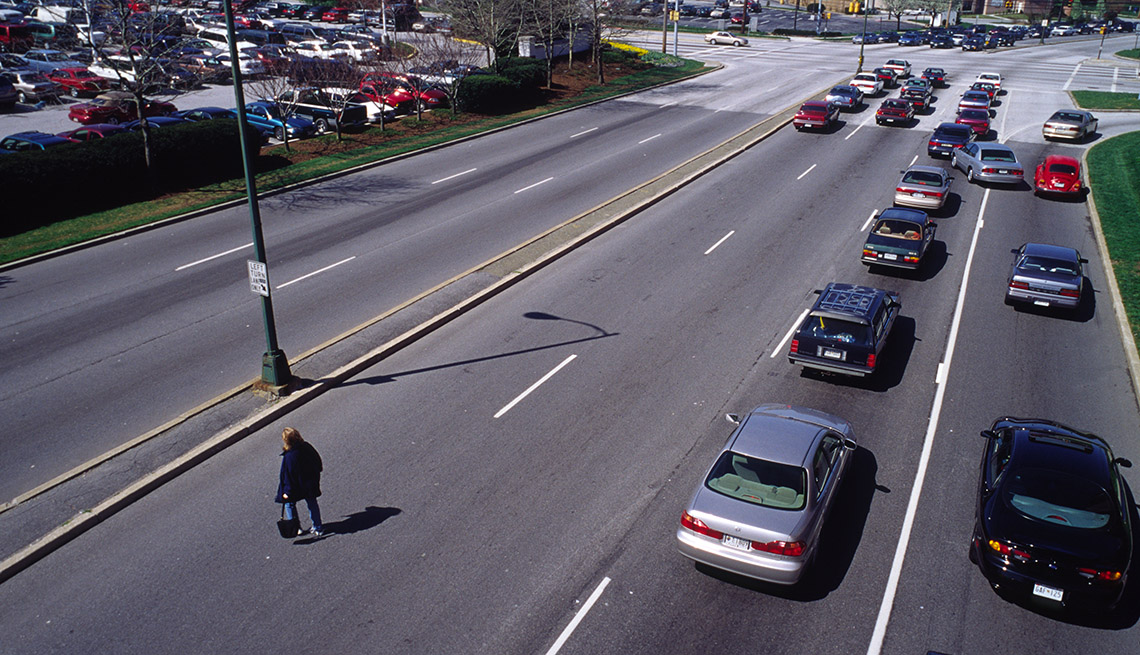
Moreover, urban streets should not have the same design criteria and standards as rural highways.
“That’s one reason state-owned roads are often among the most dangerous streets in American cities and towns,” Schmitt said.
“To provide ‘the right street in the right place’ we needed a more specific description of land use context,” FDOT’s State Complete Streets Program Manager Dewayne Carver noted, according to Chris McCahill and Rayla Bellis, at State Smart Transportation Initiative (SSTI).
Florida transportation leaders knew they had to make a change.
A 2008 First District Court of Appeals ruling after a lawsuit involving a member of the League of American Bicyclists may have helped.
The ruling states that FDOT is “obligated to establish bicycle and pedestrian ways in conjunction with the construction, reconstruction, or other change of any state transportation facilities.”
It’s important to remember that FDOT is an enormous bureaucracy with formal and informal decision-making patterns that have been built up over generations.
Florida’s New Complete Streets Plan
A few years ago, Florida transportation leaders sought to revise core documents that influence planning, programming, project development, design, and operations to incorporate a Complete Streets approach. They sought to modify current processes and decision-making approaches to implement the Complete Streets Policy.
In 2014, FDOT adopted an organization-wide Complete Streets Policy to serve the transportation needs of transportation system users of all ages and abilities.
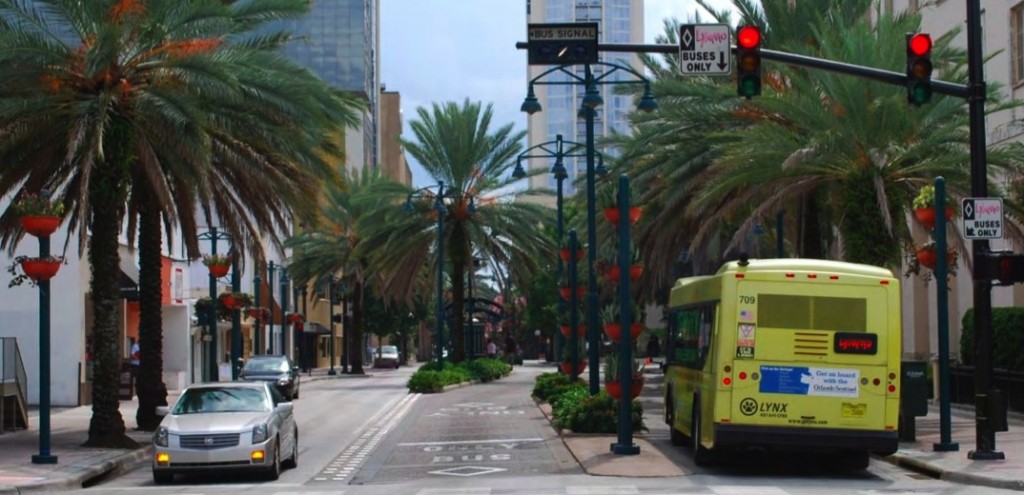
The policy calls for FDOT to coordinate with local governments, Metropolitan Planning Organizations (MPOs), transportation agencies and the public to provide Complete Streets on the State Highway System.
Compared to the 1984 policy, the “Complete Streets Policy will be integrated into the Department’s internal manuals, guidelines and related documents governing the planning, design, construction and operation of transportation facilities.”
To advance new Complete Streets policy goals, FDOT has created several initiatives, such as:
- The Complete Streets Implementation Plan. The Plan outlines a five-part implementation framework and process for integrating a Complete Streets approach into FDOT’s practices to ensure that future transportation decision and investments address the needs of all users of the transportation network and respond to community goals and context.
- The designation of Complete Streets Coordinators for each of the seven FDOT Districts. These coordinators will receive tailored training and coordinate with local governments, MPOs, transportation agencies and the public within their district to implement the Complete Streets policy.
- A Context Classification System. The context classification system provides a framework for roadway design criteria and standards according to distinguishing characteristics of various built environments, like natural, rural town, suburban commercial, and urban core.
- The FDOT Design Manual. The new design manual describes how FDOT will consider land use when making decisions about planning and road design. The FDOT Design Manual was recognized as one of the Best Complete Streets Initiatives of 2017.
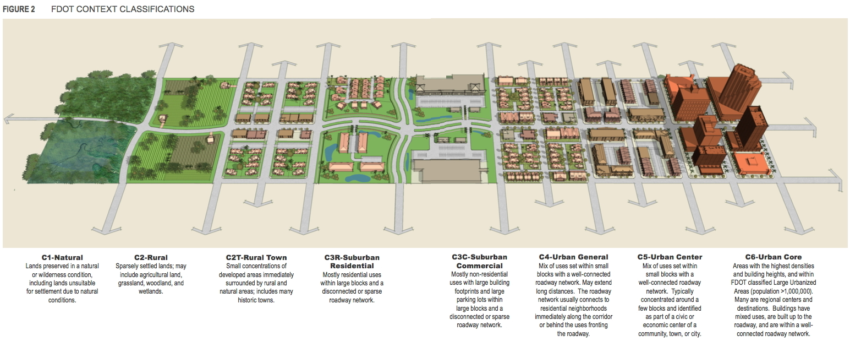
“While the [context classification system] concept is not new, Florida is among the first states to incorporate it into formal decision-making processes,” according to McCahill and Bellis.
Knowing the weak implementation of the 1984 policy, FDOT collaborated with Smart Growth America to develop an implementation plan.
Over nine months, an implementation team of internal divisions and external partners participated in the Multimodal Development and Delivery (M2D2) process to build internal capacity and identify necessary updates to FDOT’s documents and practices to align with the Complete Streets Policy.
The five-part Complete Streets Implementation Plan to institutionalize Complete Streets within its organizational policies and practices was released in 2015.
“A key step in the implementation process will be identifying performance measures that can help FDOT assess whether transportation investments are meeting the needs of all residents and achieving other Complete Streets goals at the project scale, corridor scale, and network scale,” according to the Implementation Plan.
The five-part implementation framework includes the following broad tasks: revising guidance, standards, manuals, policies, and other documents; updating decision-making processes; modifying approaches for measuring performance; managing internal and external communication and collaboration during implementation; and providing ongoing education and training.
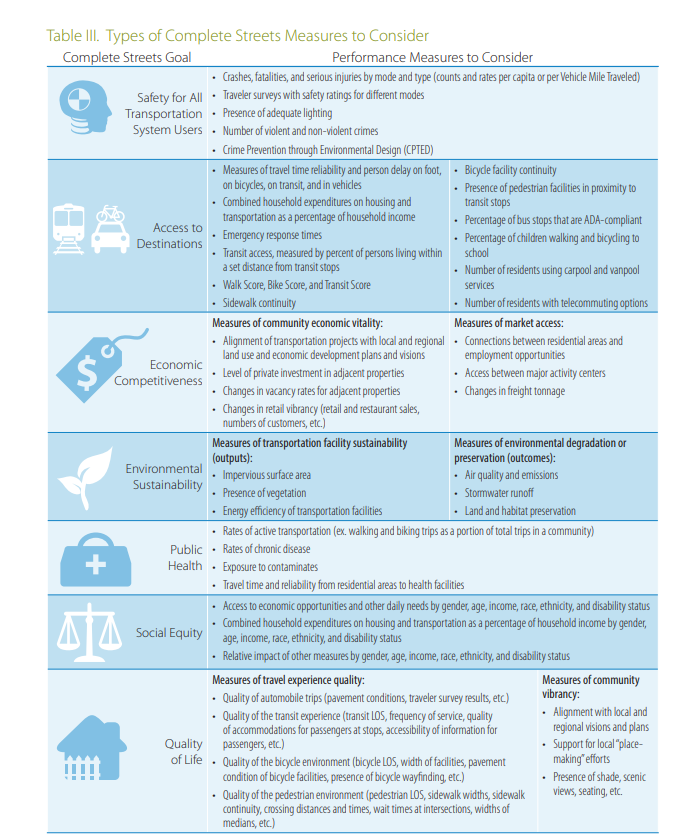
Within the broad tasks are more specific strategies, such as:
- Integrate Complete Streets into long-range plans, like the Florida Transportation Plan (FTP) and Strategic Intermodal System (SIS) Policy Plan, which together establish the policy framework for the allocation of transportation funding and the roles and responsibilities for implementing defined goals and objectives.
- Evaluate whether the criteria and measures currently being used to inform decision-making at all levels – from strategic planning and visioning, to programming and project selection, to traffic engineering decisions and evaluation – align with the objectives of the Complete Streets Policy.
- Revise the Uniform Standards for Design, Construction and Maintenance for Streets and Highways (Florida Greenbook) to update existing design standards and criteria for specific modes of travel as necessary to align with national Complete Streets best practices, and to incorporate more explicit discussion of how to consider, address, and balance the needs of all transportation system users based on context.
- Revise the Efficient Transportation Decision Making Manual to improve complete Streets criteria into the Planning Screen and Programming Screen processes to inform decision about advancing projects into cost feasible long-range plans and FDOT’s Five Year Work Program.
- Revise the Traffic Engineering Manual to address the role traffic engineering decisions play in enabling safe and convenient travel by different modes.
- Revise the Level of Service Standards for the State Highway System to clarify that LOS should be one consideration of many during design decisions.
- Revise the Quality/Level of Service (Q/LOS) Handbook to expand the existing Q/LOS measures recommended for each travel mode to align with Complete Streets objectives and national best practices, such as frequency of pedestrian crosswalks, crossing distances, presence of pedestrian refuge islands; side continuity near transit stops and proximity of pedestrian crossing near transit stops; and presents of shade, adequate pedestrian-level street lighting, and visual interest along the corridor.
- Align FDOT’s approaches for measuring performance with the goals of the Complete Streets Policy, such as crashes, fatalities, and serious injuries by mode and type; measures of travel time reliability and person delay on foot, on bicycles, on transit, and in vehicles; presence of pedestrian facilities in proximity to transit stops; impervious surface area; and rates of active
“While the Complete Streets initiative is primarily targeted at ensuring local jurisdictions have a method of communicating with FDOT regarding travel-ways that affect their communities and making sure they are considered within the context of that community, there is also the opportunity to reduce traffic crashes,” according to the FDOT 2018 Highway Safety Plan.
But how will transit be integrated? How will it affect pedestrian death rates?
Find the answers in the rest of Salud America!’s three-part series on transportation changes in Florida.
Part 2 will be out Nov. 30, 2018. Part 3 will be out Dec. 7.
Explore More:
Transportation & MobilityBy The Numbers
27
percent
of Latinos rely on public transit (compared to 14% of whites).

